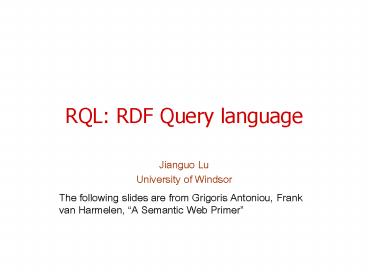RQL: RDF Query language - PowerPoint PPT Presentation
Title:
RQL: RDF Query language
Description:
Here we restrict the domain of phone to lecturers. A dot . denotes the implicit join ... Schema variables have a name with prefix $ (for classes) or _at_ (for properties) ... – PowerPoint PPT presentation
Number of Views:116
Avg rating:3.0/5.0
Title: RQL: RDF Query language
1
RQL RDF Query language
- Jianguo Lu
- University of Windsor
- The following slides are from Grigoris Antoniou,
Frank van Harmelen, A Semantic Web Primer
2
Lecture outline
- Ontology
- Syntax of RDF and RDFS
- Basic Ideas of RDF
- Three representations of RDF
- Basic Concepts of RDF Schema
- ?he Language of RDF Schema
- Axiomatic Semantics for RDF and RDFS
- Applications of RDF and RDFS
- Querying of RDF/RDFS Documents using RQL
The following slides are from Grigoris Antoniou,
Frank van Harmelen, A Semantic Web Primer
3
Why RDF Querydifferent XML representation
- XML at a lower level of abstraction than RDF
- There are various ways of syntactically
representing an RDF statement in XML - Thus we would require several XQuery queries,
e.g. - //unilecturer/unititle if unititle element
- //unilecturer/_at_unititle if unititle attribute
- Both XML representations equivalent!
4
Why RDF Queryunderstanding semantics
- ltunilecturer rdfID"949352"gt
- ltuninamegtGrigoris Antonioult/uninamegt
- lt/unilecturergt
- ltuniprofessor rdfID"949318"gt
- ltuninamegtDavid Billingtonlt/uninamegt
- lt/uniprofessorgt
- ltrdfsClass rdfabout"professor"gt
- ltrdfssubClassOf rdfresource"lecturer"/gt
- lt/rdfsClassgt
- A query for the names of all lecturers should
return both Grigoris Antoniou and David
Billington
5
RQL Basic Queries
- The query Class retrieves all classes
- The query Property retrieves all properties
- To retrieve the instances of a class (e.g.
course) we write - course
- If we do not wish to retrieve inherited
instances, then we have to write - course
- The resources and values of triples with a
specific property (e.g. involves) are retrieved
using the query - involves
- The result includes all subproperties of involves
- If we do not want these additional results, then
we have to write - involves
6
Using select-from-where
- As in SQL
- select specifies the number and order of
retrieved data - from is used to navigate through the data model
- where imposes constraints on possible solutions
- Retrieve all phone numbers of staff members
- select X,Y
- from XphoneY
- Here X and Y are variables, and XphoneY
represents a resource-property-value triple
7
Using implicit join
- Retrieve all lecturers and their phone numbers
- select X,Y
- from lecturerX.phoneY
- Implicit join We restrict the second query only
to those triples, the resource of which is in the
variable X - Here we restrict the domain of phone to
lecturers - A dot . denotes the implicit join
8
Explicit join
- Retrieve the name of all courses taught by the
lecturer with ID 949352 - select N
- from courseX.isTaughtByY, CnameN
- where Y"949352" and XC
9
Query schema
- Schema variables have a name with prefix (for
classes) or _at_ (for properties) - Retrieve all resources and values of triples with
property phone, or any of its subproperties, and
their classes - select X,X,Y,Y
- from XXphoneYY
- The domain and range of a property can be
retrieved as follows - select domain(_at_P),range(_at_P)
- from _at_P
- where _at_Pphone
10
Summary of RDF
- RDF provides a foundation for representing and
processing metadata - RDF has a graph-based data model
- RDF has an XML-based syntax to support syntactic
interoperability. - XML and RDF complement each other because RDF
supports semantic interoperability - RDF has a decentralized philosophy and allows
incremental building of knowledge, and its
sharing and reuse.
11
Summary of RDFS
- RDF Schema provides a mechanism for describing
specific domains - RDF Schema is a primitive ontology language
- It offers certain modelling primitives with fixed
meaning - Key concepts of RDF Schema are class, subclass
relations, property, subproperty relations, and
domain and range restrictions - There exist query languages for RDF and RDFS
12
RDF Schema vs XML Schema
- XML Schemas is all about syntax.
- An XML Schema tool is intended to validate that
an XML instance conforms to the syntax specified
by the XML Schema. - RDF Schema is all about semantics.
- An RDF Schema tool is intended to provide
additional facts to supplement the facts in
RDF/XML instances.
13
RDF Schema vs OO
- In OO, properties (attributes) are defined within
classes. - In RDFS, classes and properties are defined
separately.































